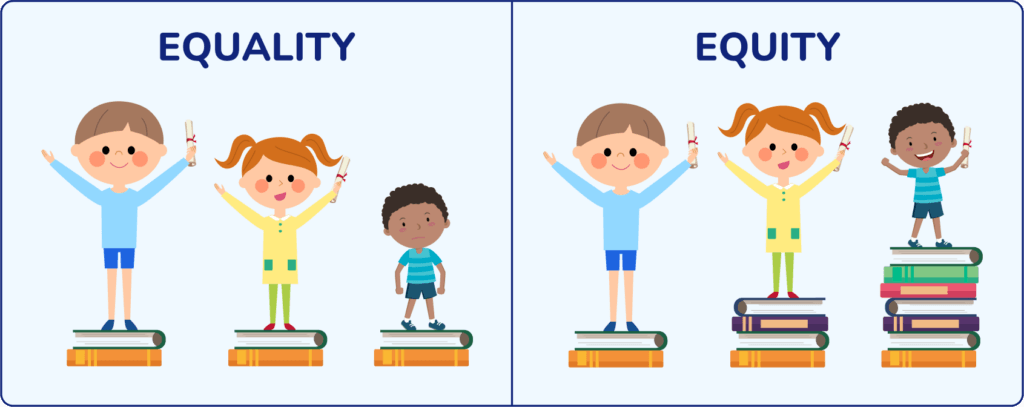Understanding Equity in Education
Educational equity means giving each student the specific support they need to succeed, no matter where they come from. It’s about creating an environment where everyone can thrive. Let’s dive into what educational equity really means and why it’s so important.
Defining and Achieving Educational Equity
Educational equity isn’t just about giving everyone the same things. It’s about recognizing that students have different needs and circumstances. To achieve equity, we need to tailor our support to address individual challenges, ensuring that everyone has a fair shot at reaching their full potential. This might mean providing additional resources to students from low-income families, offering specialized programs for students with disabilities, or creating culturally responsive classrooms that celebrate diversity. The goal is to level the playing field so that all students have the opportunity to succeed.
Overcoming the Impact of Disadvantage
Students from disadvantaged backgrounds often face systemic barriers that hinder their academic progress. These barriers can include socioeconomic factors, limited access to quality resources, and inadequate support systems. Addressing these challenges is crucial for promoting equity. For example, students from low-income families may not have access to the same educational resources as their wealthier peers, such as books, computers, and tutoring. They may also face challenges such as food insecurity, housing instability, and lack of access to healthcare, all of which can impact their academic performance. By providing targeted support to these students, we can help them overcome these barriers and achieve their full potential.
Addressing Funding Gaps
Unequal distribution of resources can worsen existing inequalities. Schools with fewer disadvantaged students often have significantly higher rates of university enrollment and scholarship attainment. This shows how funding models can unintentionally perpetuate inequality.
Strategies for Creating Equitable Systems
Creating equitable educational systems requires a multifaceted approach. This includes targeted funding for disadvantaged schools, culturally responsive teaching practices, and comprehensive support services that address the holistic needs of students. For example, schools can implement programs that provide tutoring, mentoring, and counseling services to students who need them. They can also train teachers to be culturally responsive and to create inclusive classrooms that celebrate diversity. By taking a comprehensive approach to equity, we can create educational systems that are fair and just for all students.
The Benefits of Equity for All
When all students have the opportunity to succeed, communities thrive. Educational equity fosters a more inclusive and prosperous society, benefiting everyone by unlocking the potential of all its members. When we invest in education, we are investing in the future of our communities. By ensuring that all students have the opportunity to succeed, we can create a more equitable and prosperous society for all.
Overcoming Regional Disparities in Education
Educational equity is still a major challenge, and we need to pay attention to the regional differences that affect how well students do. Fixing these inequalities is key to creating learning environments that are inclusive and work for everyone.
Understanding the Roots of the Divide
Differences in education often stem from deep-seated systemic issues, disproportionately affecting marginalized communities. These challenges include variations in school funding, resources, and access to qualified educators, which can significantly impact academic achievement. For example, schools in low-income areas may not have the resources to provide students with the same opportunities as schools in wealthier areas. This can lead to a cycle of poverty and inequality that is difficult to break.
The Importance of Resource Allocation
Unequal resource allocation plays a pivotal role in perpetuating educational disparities. Schools in underserved areas often lack the necessary funding for up-to-date resources, technology, and specialized programs, hindering students’ opportunities. For example, schools in low-income areas may not have the resources to provide students with the same access to technology as schools in wealthier areas. This can put students at a disadvantage when it comes to preparing for college and careers.
Strategies for Addressing Systemic Barriers
Overcoming educational disparities requires targeted interventions and policy changes. These strategies should focus on equitable resource distribution, teacher training, and culturally responsive teaching practices to support all students. For example, states can implement funding formulas that provide additional resources to schools in low-income areas. They can also invest in teacher training programs that focus on culturally responsive teaching practices. By taking these steps, we can create a more equitable educational system for all students.
Achieving Gender Balance in Education
Educational equity requires a careful look at how gender plays out in learning environments. Understanding these dynamics is essential for creating spaces that are inclusive and supportive for all students.
Analyzing Educational Attainment Trends
Recent data highlights interesting trends in educational attainment. It’s important to consider how these trends impact equity initiatives and how institutions can respond effectively to support all students. For example, there has been a significant increase in the number of women earning bachelor’s degrees in recent years. This trend has important implications for equity initiatives and for how institutions support all students.
The Changing Gender Dynamics in Higher Education
There’s growing awareness of a shifting landscape in higher education. For example, recent research indicates that a greater percentage of young women are achieving bachelor’s degrees compared to young men. Specifically, among adults aged 25-34, 47% of women hold a bachelor’s degree, compared to 37% of men.
| Gender | Age Group | Bachelor’s Degree Attainment (%) | Year |
|---|---|---|---|
| Women | 25-34 | 47 | 2024 |
| Men | 25-34 | 37 | 2024 |
Data source: Pew Research Center “More young women than men have college degrees” (analysis based on U.S. Census Bureau Current Population Survey Annual Social and Economic Supplement) November,2024
Addressing Complex Equity Issues
These statistics point to complex equity dynamics within education. While women are excelling academically, it’s important to consider other factors that contribute to a balanced learning environment. This includes examining potential disparities in fields of study, access to resources, and career opportunities post-graduation. For example, while women are earning more bachelor’s degrees overall, they may still be underrepresented in certain fields of study, such as science, technology, engineering, and mathematics (STEM). It’s important to address these disparities and to ensure that all students have equal access to opportunities, regardless of their gender.
Empowering Students Through Policy
Looking at educational equity means seeing how policies can create a level playing field. It’s about giving all learners, no matter their background, the chance to succeed in school and beyond.
The Role of Financial Aid
Many regions are prioritizing need-based financial aid. These initiatives often include grants designed to help students with fewer resources access educational opportunities. Such support addresses financial barriers and allows more learners to participate in higher education. By providing financial assistance to students from low-income families, we can help them overcome financial barriers and achieve their educational goals.
Supporting Underrepresented Students
Targeted programs are being developed to support underrepresented groups. These may include transition programs and outreach efforts. These initiatives aim to create a more inclusive environment where all students feel welcome and supported throughout their educational journey. For example, colleges and universities can implement bridge programs that help students from underrepresented groups transition to college. They can also conduct outreach to high schools in underserved communities to encourage more students to apply to college.
The Importance of Flexibility for Adult Learners
Policies are adapting to better serve adult learners, as well. Flexible scheduling and credit for prior learning are becoming more common. By recognizing diverse learning paths, educational institutions can better support the growing number of nontraditional students. For example, colleges and universities can offer online courses and flexible scheduling options to accommodate the needs of adult learners. They can also grant credit for prior learning, allowing adult learners to receive credit for their work experience and other life experiences.
The Power of Technology in Bridging Resource Gaps
Educational equity is still a major challenge, but new technologies offer promising ways to close resource gaps. By using these advances, we can create learning environments that are more inclusive and effective for everyone.
The Growth of EdTech
The EdTech market is experiencing substantial growth, driven by the increasing recognition of technology’s potential to address educational disparities. Projections indicate a significant expansion, with market size estimated to reach $42.92 billion. This growth underscores the growing investment in and adoption of technological solutions in education.
AI-Driven Personalized Learning
AI plays a crucial role in tailoring learning experiences to individual needs. Personalized learning platforms can adapt to different learning styles and paces, ensuring that every student receives the support they require. This level of customization is particularly beneficial for students who may be falling behind or require additional challenges. For example, AI-powered tutoring systems can provide students with personalized feedback and support, helping them to master concepts at their own pace.
Enhancing Engagement Through Gamification
Gamification techniques enhance student engagement and motivation. By incorporating game-like elements into the learning process, educators can make lessons more interactive and enjoyable. This approach can be especially effective in reaching students who may be disengaged from traditional classroom settings. For example, teachers can use game-based learning platforms to create engaging lessons that motivate students to learn.
Using Advanced Analytics for Better Insights
Advanced analytics provide educators with valuable insights into student performance and learning patterns. By analyzing data on student progress, teachers can identify areas where students are struggling and adjust their instruction accordingly. This data-driven approach allows for more targeted and effective interventions. For example, teachers can use data analytics to identify students who are at risk of falling behind and to provide them with additional support.
Creating Immersive Experiences with AR/VR
Augmented and virtual reality technologies create immersive learning environments that can enhance understanding and retention. These technologies allow students to explore complex concepts in a hands-on, interactive way. The engaging nature of AR/VR can help to make learning more accessible and enjoyable for diverse learners.
| Year | U.S. EdTech Market Size (USD Billions) | CAGR (2025-2034) | Projected Market Size in 2034 (USD Billions) |
|---|---|---|---|
| 2025 | 42.92 | 21.1% | 242.19 |
Data source: Sci-Tech-Today “Edtech Statistics By Market, Technology And Innovation (2025)” Published: July,2025
By leveraging the power of technology, we can create more equitable and effective learning environments for all students.
Q&A
Question 1: What is the core concept of educational equity, and how does it differ from simply providing equal resources?
Answer: Educational equity goes beyond providing equal resources; it acknowledges diverse student needs and circumstances. It focuses on tailoring support to address individual challenges, ensuring every student has a fair chance to reach their full potential, regardless of their background. Equal resources don’t account for pre-existing disadvantages.
Question 2: The provided data shows a stark difference in university enrollment and scholarship attainment based on the percentage of disadvantaged students in a high school. What does this disparity highlight regarding funding models?
Answer: The data reveals that funding models can inadvertently perpetuate inequality. Schools with fewer disadvantaged students have significantly higher rates of university enrollment and scholarship attainment. This suggests that current funding mechanisms may not adequately address the needs of students from disadvantaged backgrounds, exacerbating existing inequities.
Question 3: What are some strategies mentioned in the text for achieving educational equity, and how do they address systemic barriers?
Answer: Strategies include targeted funding for disadvantaged schools, culturally responsive teaching practices, and comprehensive support services addressing students’ holistic needs. These address systemic barriers by directly providing resources to underserved schools and communities, tailoring instruction to diverse cultural backgrounds, and offering support beyond academics to overcome challenges stemming from socioeconomic factors.







